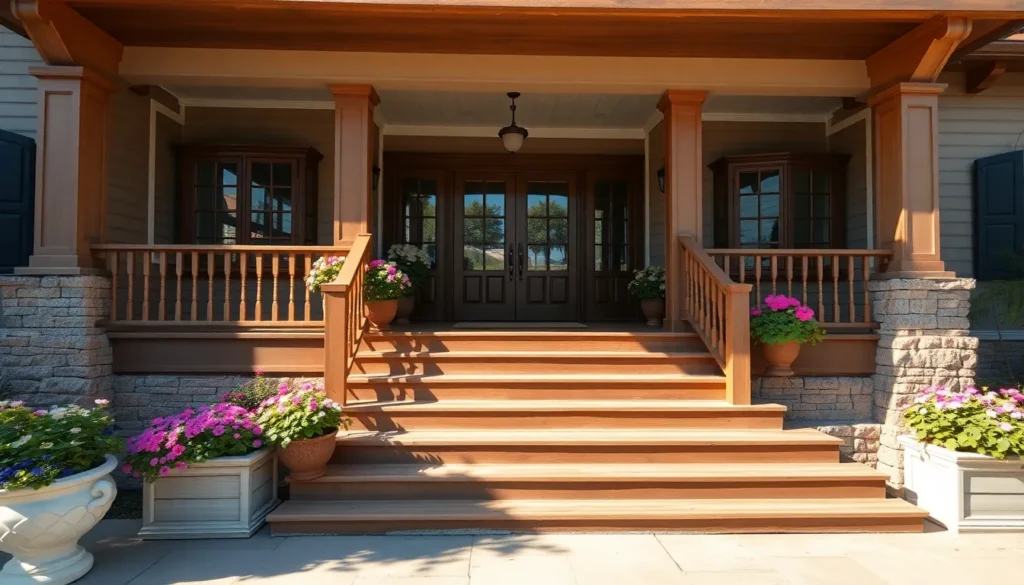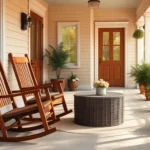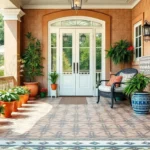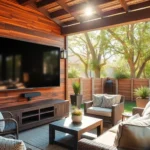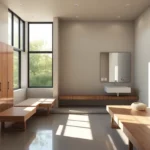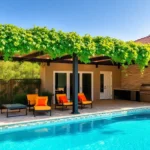We’ve all walked up to a home and felt instantly drawn to its welcoming entrance – and nothing creates that magnetic first impression quite like thoughtfully designed front porch stairs. Whether you’re building new or updating existing steps your staircase sets the tone for your entire home’s aesthetic.
Front porch stairs aren’t just functional pathways – they’re architectural statements that can transform your curb appeal overnight. From classic wooden designs that exude timeless charm to modern concrete steps with sleek lines we’ll explore ideas that match every style and budget. The right stair design doesn’t just guide guests to your door it creates an inviting journey that makes everyone feel welcome.
Ready to discover how the perfect front porch stairs can elevate your home’s exterior? We’re diving into inspiring designs practical materials and expert tips that’ll help you create stairs worth admiring. Your dream entrance is closer than you think.
Classic Wooden Stair Designs That Never Go Out of Style
Wooden stairs remain our most popular choice for front porch designs because they offer timeless appeal and versatile styling options. Natural wood materials create warmth and character that complements virtually any architectural style.
Traditional Straight Wooden Steps
Straight wooden steps provide the foundation for countless front porch stair designs across America. We recommend using pressure-treated lumber like cedar, redwood, or composite materials for their durability and resistance to weather elements. Standard construction typically features 2×12 stringers with 2×10 treads, creating sturdy platforms that support daily foot traffic.
Painting these steps in classic colors enhances their traditional appeal significantly. White painted steps create crisp contrast against brick or siding, while natural wood stains showcase the grain patterns and texture. We’ve observed that homeowners often choose darker stains like mahogany or walnut for Victorian-style homes, creating rich visual depth.
Safety features integrate seamlessly into traditional designs without compromising aesthetics. Adding textured strips or outdoor carpet runners prevents slipping during wet conditions. Proper lighting installation along the step edges improves visibility while maintaining the classic appearance.
Curved Wooden Staircase with Railings
Curved wooden staircases transform ordinary front porches into elegant architectural features. These designs require skilled craftsmanship to achieve smooth, flowing lines that guide visitors gracefully to your entrance. We typically see radius measurements between 4 to 8 feet for residential applications, depending on available space and desired visual impact.
Railing systems complete the curved stair aesthetic while providing essential safety support. Matching wooden balusters with decorative post caps create cohesive design elements throughout the structure. Popular railing heights range from 34 to 38 inches, meeting most local building codes while offering comfortable hand placement.
Construction complexity increases with curved designs, often requiring custom-cut stringers and specialized joinery techniques. Professional installation ensures proper structural integrity and smooth radius execution. Material costs typically run 40-60% higher than straight stairs due to the additional cutting and fitting requirements.
Rustic Log Stair Construction
Log stair construction brings natural woodland charm to front porch designs. We use full logs or half-log faces to create substantial, organic-looking steps that complement cabin-style homes and rustic architectural themes. Cedar and pine logs work exceptionally well due to their natural resistance to insects and decay.
Building techniques involve notching logs to create stable, interlocking connections between treads and risers. Each step typically uses 8-12 inch diameter logs, providing generous depth for comfortable foot placement. We recommend sealing all log surfaces with penetrating wood stain or clear protective finish to extend lifespan.
Maintenance requirements differ from traditional lumber construction, as logs may develop checking or small cracks over time. Regular inspection and re-sealing every 2-3 years keeps the wood protected from moisture damage. These natural characteristics add to the rustic appeal rather than detract from the overall appearance.
Modern Concrete Stair Solutions for Contemporary Homes
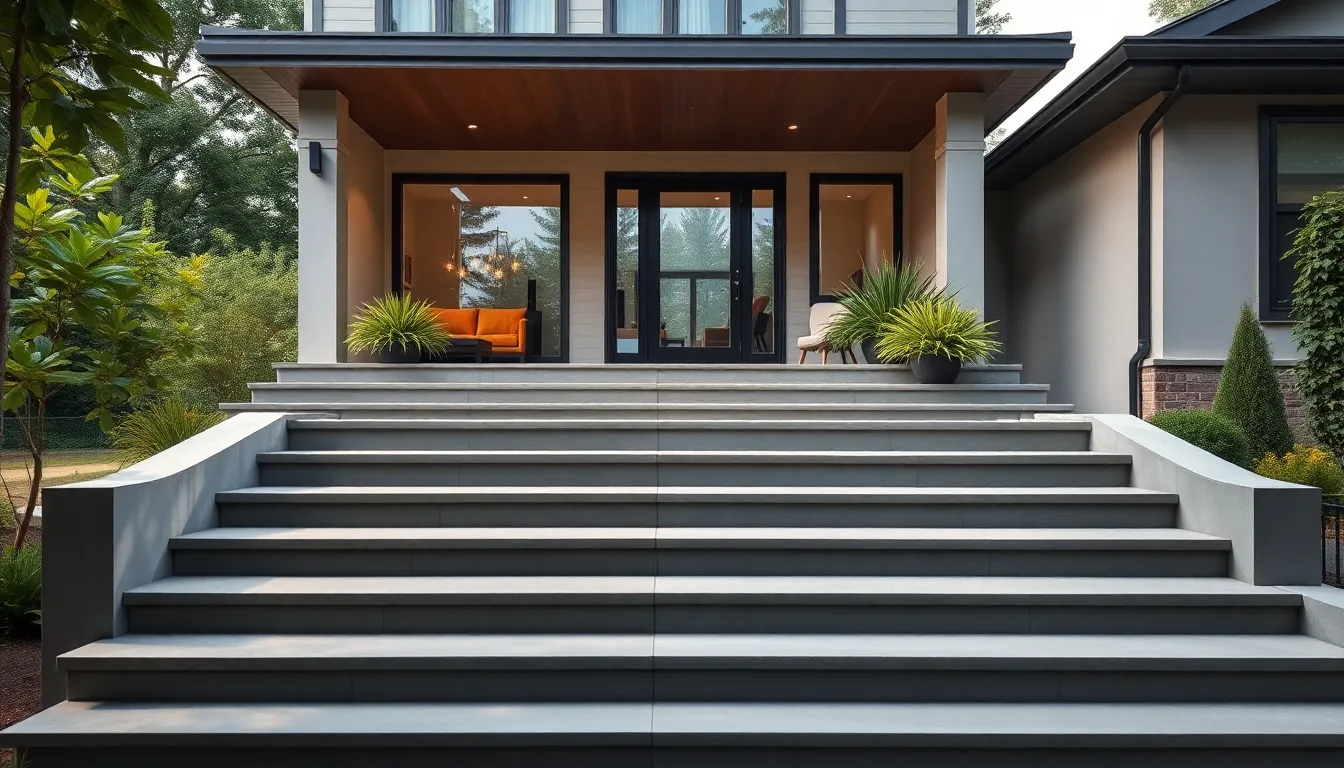
Contemporary homes benefit from concrete’s architectural versatility and long-lasting performance. These modern answers offer homeowners durable alternatives that seamlessly blend functionality with cutting-edge design aesthetics.
Sleek Poured Concrete Steps
Poured concrete steps deliver the clean, minimalist appearance that contemporary home design demands. Contractors can form these steps to precise dimensions, creating smooth and seamless staircases that integrate perfectly with modern façades. The material’s solid nature supports exceptional structural integrity for long-term use with minimal maintenance requirements.
We recommend poured concrete for homes in varied climates since it withstands temperature fluctuations and weather extremes effectively. Homeowners appreciate the customization possibilities, as contractors can adjust dimensions and angles to match exact architectural requirements. The seamless finish eliminates joints and gaps that typically collect debris or require frequent cleaning.
Stamped Concrete Patterns and Textures
Stamped concrete transforms ordinary steps into decorative focal points through intricate patterns and realistic textures. This technique allows homeowners to mimic premium materials like natural stone, brick, or wood grain without the associated costs or maintenance demands. Experienced contractors carefully execute the stamping process to ensure patterns flow naturally with the home’s overall aesthetic design.
Texture selection plays a crucial role in achieving authentic appearances that complement contemporary architecture. Stone patterns work particularly well for modern homes seeking organic elements, while geometric designs enhance ultra-modern properties. Proper timing during the stamping process ensures crisp pattern definition that won’t fade or blur over time.
Concrete Steps with Integrated Planters
Integrated planters soften concrete’s hard lines through strategic placement of greenery and natural elements. This contemporary approach creates harmony between modern materials and industry design, making front porches more welcoming and visually appealing. Drainage systems within the planter areas prevent water damage while supporting healthy plant growth throughout different seasons.
Designers typically position planters along step edges or incorporate them into wider landing areas for maximum visual impact. Seasonal plantings allow homeowners to refresh their entrance appearance regularly, while evergreen options provide year-round color and texture. The combination of concrete durability and living elements creates distinctive entrances that stand out in contemporary neighborhoods.
Natural Stone Stair Ideas for Elegant Curb Appeal
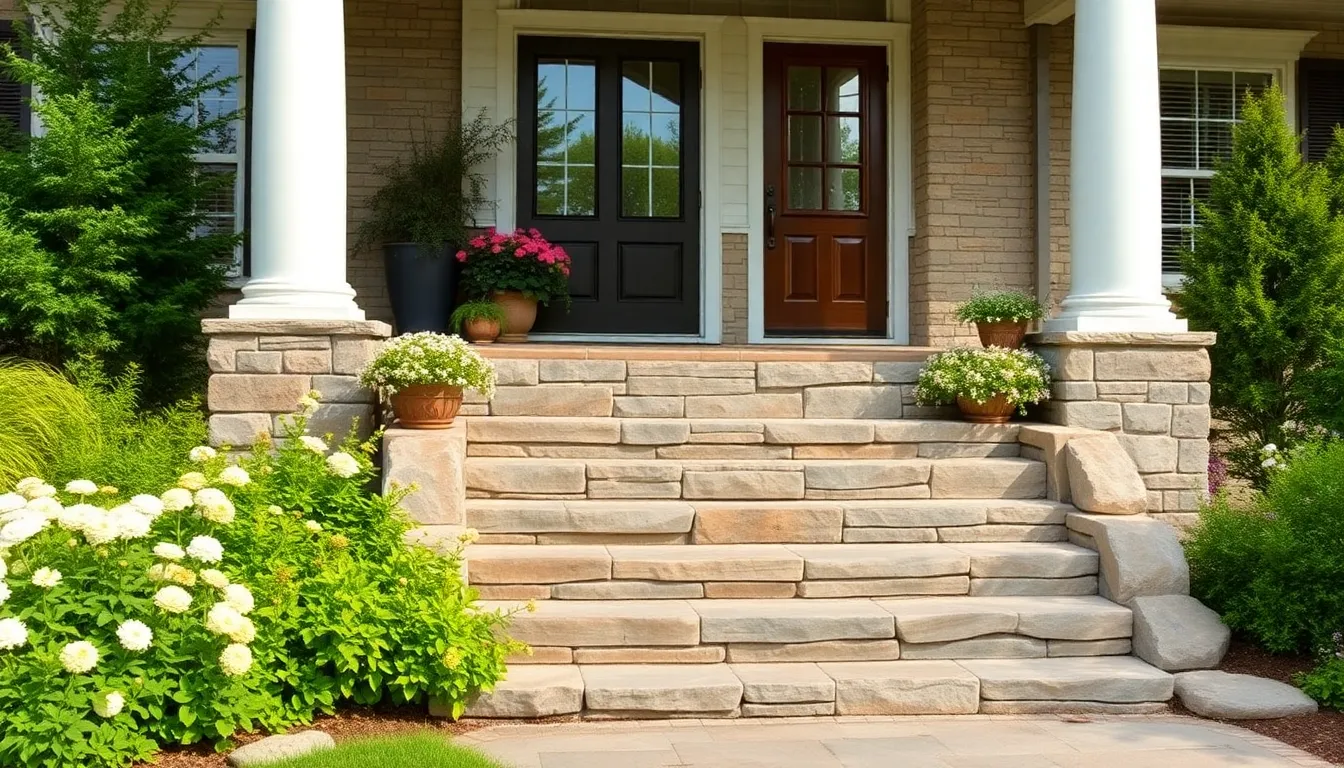
Natural stone stairs offer unmatched durability and sophisticated beauty that elevates any front porch design. We’ll explore three stunning stone options that create lasting impressions while providing functional access to your home.
Flagstone Step Installation
Flagstone steps deliver classic appeal through their naturally irregular shapes and earthy color variations. This versatile stone material works exceptionally well for both casual and traditional home styles, creating a refined yet approachable entrance.
Installation requires a stable foundation using either compacted gravel or mortar bed to ensure safety and longevity. Each flagstone piece fits together like a natural puzzle, allowing for creative arrangements that complement your home’s architecture.
Color options range from warm sandstone to cool gray tones, providing flexibility to match existing exterior elements. Flagstone pairs beautifully with lush greenery planted along the risers, creating an integrated look that feels organic and welcoming.
Maintenance involves occasional cleaning and resealing to preserve the stone’s natural beauty and prevent weather damage. We recommend choosing thicker flagstone pieces for high traffic areas to maximize durability.
Granite Slab Staircase Design
Granite slab stairs represent the pinnacle of luxury and durability for front porch construction. These wide, seamless treads create clean lines that work perfectly with both modern and classic architectural styles.
Natural speckling patterns in granite provide visual interest while maintaining an elegant, sophisticated appearance. Color variations span from light gray to deep black, allowing customization to match your home’s exterior palette.
Minimal grout lines between slabs create a sleek, continuous surface that’s easy to maintain and clean. The polished finish reflects light beautifully, adding brightness to covered porch areas.
Cutting granite requires professional expertise to achieve precise measurements and smooth edges. We recommend working with experienced stone contractors to ensure proper installation and structural integrity.
Slip resistance can be enhanced through honed finishes that provide better traction in wet conditions while maintaining the stone’s premium appearance.
Fieldstone Stacked Steps
Fieldstone stacked steps embrace a rustic, handcrafted aesthetic that suits cottage and country home styles perfectly. These naturally weathered stones create substantial visual weight and organic texture at your entrance.
Stacking techniques vary from dry stacking without mortar to minimal mortar application that preserves the natural, irregular appearance. Each stone’s unique shape contributes to the overall character and charm of the staircase.
Texture and color variations in fieldstone create depth and visual interest that changes throughout the day as lighting conditions shift. The rugged appearance works exceptionally well with complementary natural landscaping elements.
Installation flexibility allows for creative arrangements that accommodate sloped terrain and irregular porch layouts. Fieldstone steps can be built to follow natural contours, creating a more integrated look with the surrounding industry.
Complementary plantings around fieldstone steps enhance the natural aesthetic, with moss and small perennials naturally establishing themselves in the stone crevices over time.
Creative Brick Stair Configurations

Brick stairs offer endless possibilities for creating unique and visually striking front porch entrances. We can transform ordinary steps into architectural masterpieces by exploring different brick patterns, colors, and installation techniques.
Traditional Red Brick Steps
Red brick steps deliver timeless charm and exceptional durability that never goes out of style. We recommend using standard rectangular bricks with clean, uniform mortar joints to achieve that classic look homeowners love. These steps feature natural red tones that complement various siding materials like vinyl, wood, or stone.
Matching red brick stairs to traditional house exteriors creates a cohesive design that enhances curb appeal instantly. We find that red brick works particularly well with white, cream, or dark green front doors, creating that welcoming entrance every home needs. The rustic appeal of traditional red brick makes it perfect for colonial, craftsman, or farmhouse architectural styles.
Installation typically involves creating a solid foundation with proper drainage to prevent settling over time. We suggest using weather resistant mortar to ensure longevity, especially in areas with freeze thaw cycles that can damage weaker joints.
Mixed Brick and Mortar Patterns
Mixed patterns transform ordinary brick stairs into custom focal points that reflect personal style preferences. We can combine different brick colors, sizes, or textures with contrasting mortar colors to create stunning visual effects. Popular combinations include alternating red and tan bricks with white mortar, or using charcoal bricks with light gray mortar for modern appeal.
Incorporating stone or concrete inserts between brick sections adds dimensional interest that catches the eye immediately. We often see homeowners use colored mortar to outline each brick, emphasizing geometric patterns like herringbone or basketweave designs on stair treads.
These creative configurations work exceptionally well when we want to highlight the stair geometry while maintaining structural integrity. The contrast between materials creates depth and personality that makes each porch unique to its home.
Painted Brick Stair Makeover
Painting existing brick stairs offers an affordable transformation that delivers dramatic results without major renovations. We can instantly refresh older brickwork with popular paint schemes like whitewashed finishes, solid neutral colors, or bold contrasting designs.
Creating crisp modern looks becomes simple when we paint stair risers white with gray treads, providing a clean backdrop for colorful seasonal décor. Coordinating stair colors with house siding or front door paint enhances overall curb appeal while maintaining design cohesion throughout the exterior.
We recommend using high quality masonry paint designed specifically for brick surfaces to ensure proper adhesion and weather resistance. Preparation involves cleaning the brick thoroughly and applying primer before the final paint coat for best results that last multiple seasons.
Metal Stair Designs for Industrial and Modern Aesthetics
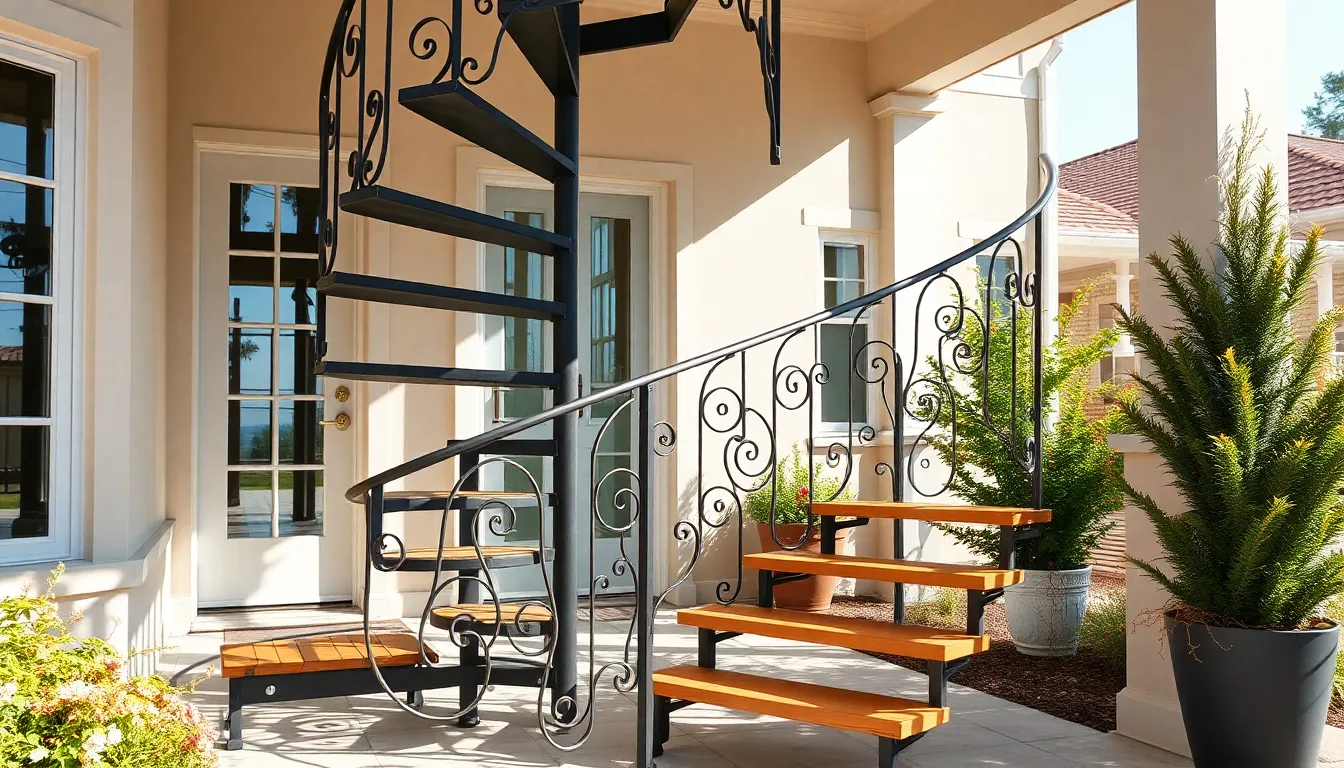
Metal staircases offer unparalleled durability while creating striking architectural statements that complement contemporary home designs. These materials excel at bridging the gap between industrial strength and sophisticated aesthetics.
Wrought Iron Spiral Staircases
Wrought iron spiral staircases deliver a classic yet strong aesthetic that maximizes space efficiency while adding decorative flair. We’ve found these designs particularly effective for creating artistic industrial looks through intricate metalwork patterns that suit both vintage and modern exteriors perfectly.
Artists can customize these staircases with elaborate scrollwork, geometric patterns, and ornamental details that serve as functional sculptures. Durability remains exceptional since wrought iron withstands harsh weather conditions for decades with minimal maintenance required.
Powder coating provides color customization options while offering superior corrosion protection compared to traditional painting methods. Homeowners can choose from many color combinations that coordinate with existing exterior elements, ensuring seamless visual integration with their porch design.
Space saving benefits make spiral configurations ideal for smaller front porches where traditional straight stairs might overwhelm the available area. Construction costs typically range higher than basic metal stairs due to the specialized craftsmanship required for spiral formations.
Steel Frame Steps with Wood Treads
Steel frame steps with wooden treads merge industrial toughness with natural warmth, creating an appealing hybrid design. We recommend this combination because steel provides a sturdy, low maintenance structure that supports wooden steps, which offer soft, inviting texture for front porch applications.
Modern designers favor this approach for blending raw metal with organic wood elements, improving curb appeal while ensuring exceptional longevity. Steel frames typically last 20-30 years with proper maintenance, while wooden treads can be replaced individually as needed without compromising structural integrity.
Construction involves welding steel stringers and frames, then mounting wooden treads using hidden fasteners or decorative bolts. Popular wood choices include pressure treated lumber, cedar, and composite materials that resist moisture and insects effectively.
Maintenance requirements include periodic wood staining or sealing every 2-3 years, while steel components need occasional touch up painting to prevent rust formation. This design works exceptionally well with ranch style, contemporary, and industrial themed homes.
Aluminum Stair Systems
Aluminum stairs provide lightweight, rust resistant answers that require minimal upkeep, making them perfect for outdoor porch installations. We appreciate these systems because they can be prefabricated or custom built to fit various porch sizes and architectural styles.
Sleek, modern appearances make aluminum ideal for minimalist and contemporary home exteriors, supporting both straight and spiral stair configurations effectively. Weight advantages allow for easier installation compared to steel or iron alternatives, often reducing labor costs significantly.
Prefabricated systems typically cost 30-40% less than custom welded options while still providing excellent structural performance. Manufacturers offer modular components that simplify installation and allow for future modifications if needed.
Corrosion resistance eliminates the need for regular painting or coating maintenance, though periodic cleaning maintains optimal appearance. Aluminum accepts powder coating well, providing color options that coordinate with siding, trim, and other exterior elements seamlessly.
Thermal expansion considerations require proper installation techniques to accommodate temperature fluctuations without creating structural stress. Professional installation ensures proper spacing and mounting for long term performance.
Composite and Alternative Material Options
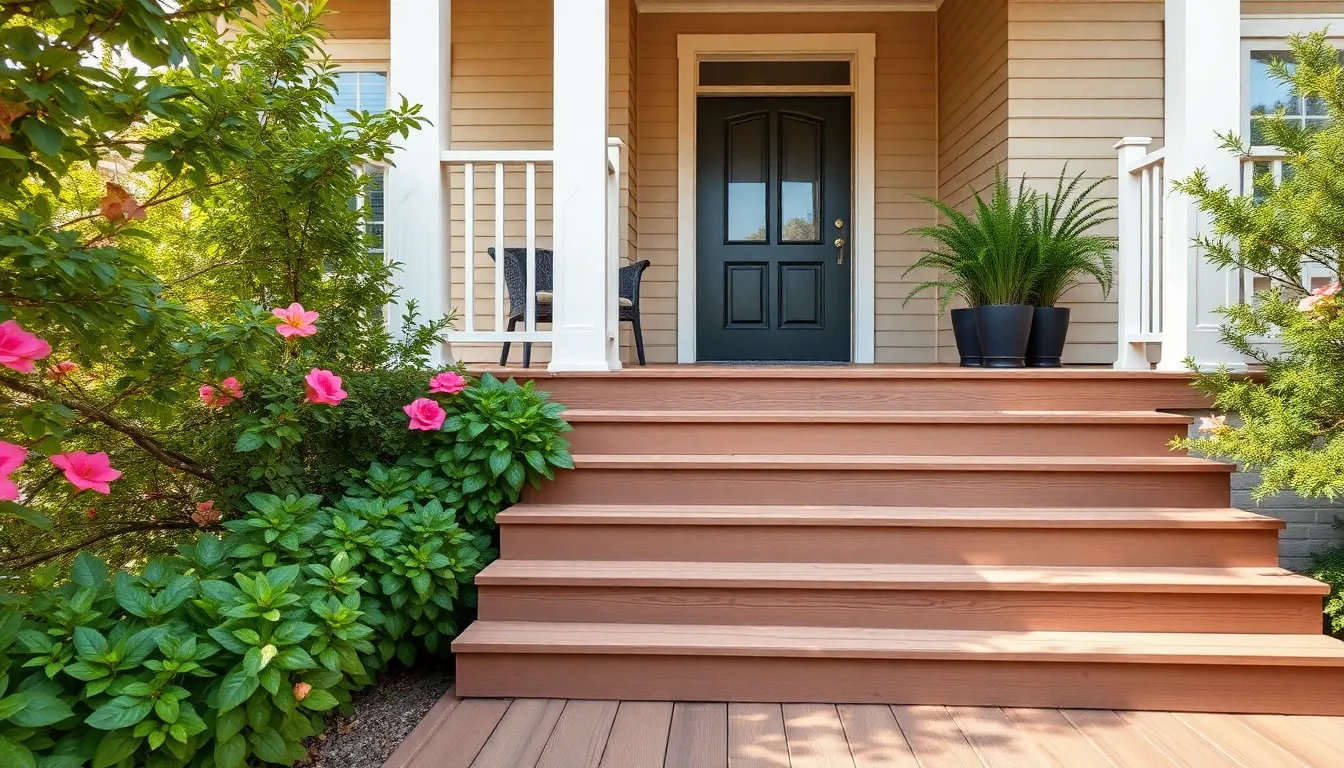
Modern materials offer exceptional durability and low maintenance alternatives to traditional stair construction. We’ll explore how these innovative options can transform your front porch stairs into long lasting and stylish architectural features.
Composite Decking Stair Treads
Composite decking stair treads combine the best aspects of wood and plastic into one superior material. Made from a blend of wood fibers and recycled plastic, these treads resist rot, splintering, and insect damage that commonly plague traditional wooden steps. We find composite materials particularly valuable because they maintain their appearance without requiring regular staining or sealing.
Various colors and textures mimic natural wood grain, giving you styling flexibility while ensuring longevity. Installation follows similar methods to traditional wood treads, making the transition straightforward for contractors familiar with standard construction techniques. Composite treads perform exceptionally well in harsh weather conditions, maintaining structural integrity through temperature fluctuations and moisture exposure.
Recycled Plastic Step Answers
Recycled plastic steps represent an eco friendly choice that delivers outstanding weather resistance and durability. These steps consist entirely of recycled plastics, making them an environmentally conscious option for homeowners prioritizing sustainability. We appreciate how recycled plastic withstands moisture, mold, and insects without warping or cracking over time.
Commercial and coastal applications frequently use recycled plastic steps due to their exceptional resistance to salt air and extreme weather conditions. Residential front porches increasingly feature these steps as homeowners recognize their longevity benefits and environmental advantages. Recycled plastic steps require virtually no maintenance while providing decades of reliable service.
Mixed Material Combinations
Combining different materials enhances both durability and visual appeal in front porch stair design. We recommend using composite or recycled plastic for stair treads while incorporating natural wood or metal for structural elements like stringers and railings. This approach maximizes the strengths of each material while creating interesting visual contrasts.
Natural wood treads paired with painted risers that match your home’s exterior color create cohesive curb appeal. Metal railings provide modern accents and structural support while complementing composite treads beautifully. Stone or concrete bases combined with composite or wooden steps achieve a rustic yet contemporary aesthetic that suits various architectural styles.
Painting stair risers in coordinating colors while maintaining neutral gray or white treads offers a clean classic appearance. Natural wood treads with painted risers enhance farmhouse or rustic styling perfectly. We find these mixed material approaches allow for greater customization while ensuring structural integrity and reduced maintenance requirements.
Lighting Integration Ideas for Stair Safety and Ambiance
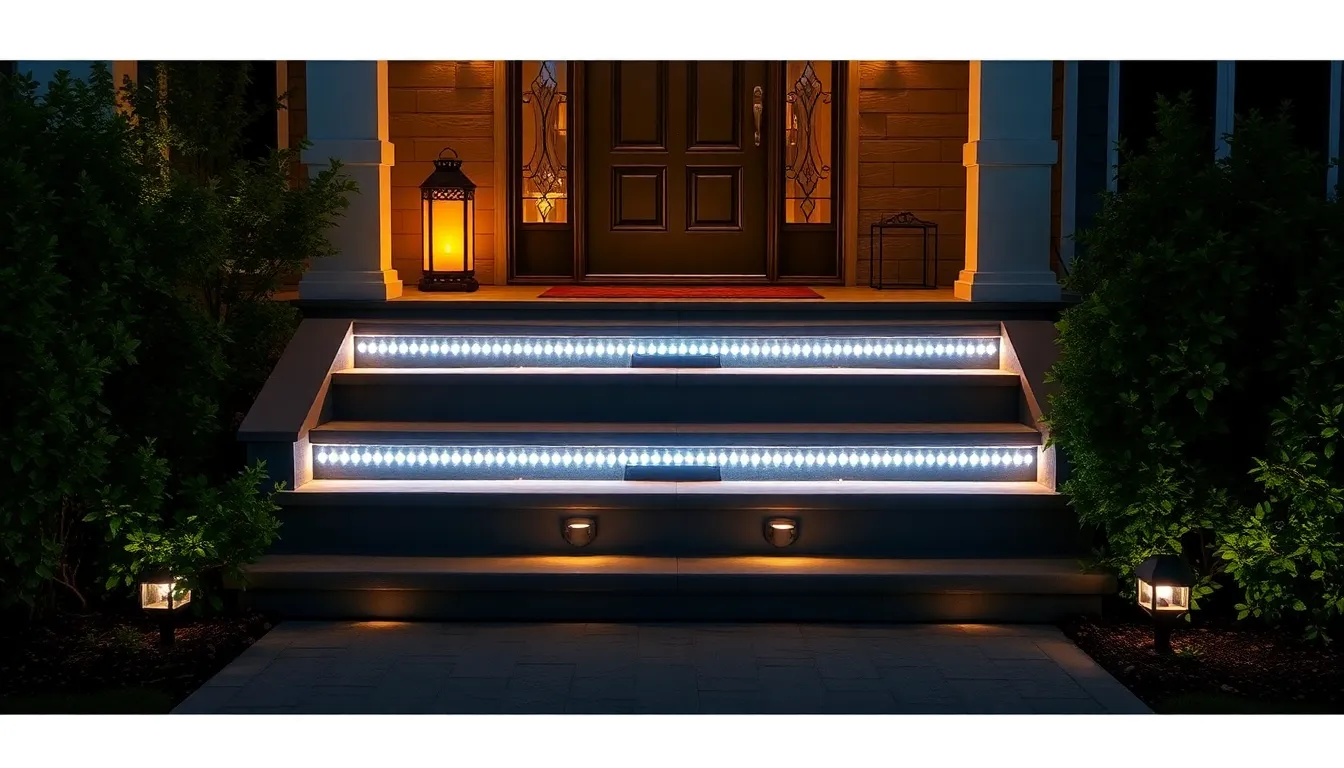
Proper illumination transforms functional front porch stairs into welcoming architectural features while ensuring safe navigation during evening hours. We’ll explore three effective lighting answers that balance safety requirements with aesthetic appeal.
Built-in LED Strip Lighting
Built-in LED strip lighting provides continuous, low-profile illumination by installing along the underside of stair treads or handrails. This method creates a sleek, modern appearance while softly outlining each step for safer navigation in darkness.
LED strips deliver energy-efficient performance and can be customized in both length and color temperature to match your design preferences. These systems offer ambient lighting without harsh glare, improving the stairs’ visual appeal alongside their functional benefits.
Installation typically involves routing the strips through channels or mounting brackets, creating a seamless integration with your stair structure. Color temperature options range from warm 2700K for cozy atmospheres to cool 5000K for contemporary designs.
Solar-Powered Step Lights
Solar-powered step lights offer a sustainable lighting solution that requires no electrical wiring since they’re powered by sunlight collected throughout the day. These fixtures are commonly installed on stair risers or adjacent side walls and automatically activate at dusk.
Installation becomes significantly simpler without the need for electrical connections, making them ideal for DIY projects. Energy costs remain minimal while reducing environmental impact through renewable solar power.
Brightness levels depend on daily solar exposure and weather conditions, which may affect lighting consistency during cloudy periods. Battery backup systems in quality solar lights help maintain illumination for several hours after sunset.
Placement considerations include ensuring adequate sun exposure during daytime hours and positioning lights to avoid shadows from railings or overhangs.
Decorative Lantern Placement
Decorative lanterns add both charm and practical illumination when strategically positioned near front porch stairs. These fixtures can be hung from porch ceilings, mounted on posts, or placed directly on stair landings for maximum impact.
Lanterns provide warmer, diffused lighting that enhances the overall ambiance and aesthetic appeal of your porch entrance. Traditional styles complement rustic and cottage designs, while contemporary lanterns suit modern architectural themes.
Combining lanterns with focused LED lighting creates layered illumination by mixing functional and decorative elements. This approach ensures adequate safety lighting while maintaining the welcoming atmosphere that makes guests feel comfortable approaching your home.
Size selection should correspond to your stair scale, with larger lanterns for wider staircases and smaller options for compact entryways.
Railing and Handrail Design Considerations
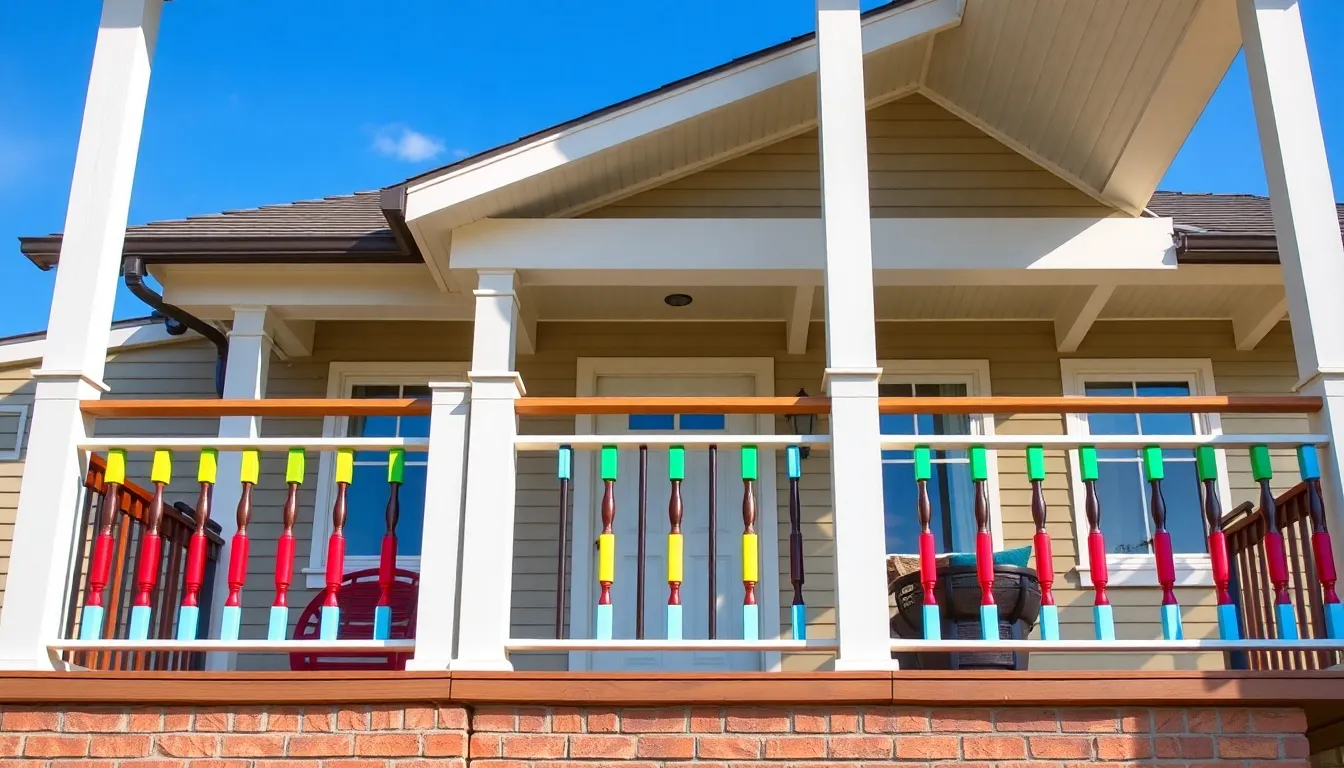
We need to balance safety with style when designing railings and handrails for front porch stairs. These elements not only provide essential support but also serve as prominent design features that can dramatically enhance your home’s curb appeal.
Wooden Baluster Options
Wooden balusters offer classic charm that complements traditional architectural styles beautifully. We recommend selecting profiles and shapes that align with your home’s existing design elements for maximum visual impact. Traditional turned balusters work wonderfully with colonial and craftsman style homes, while square or rectangular balusters suit more contemporary designs.
Customization becomes effortless with wood since you can stain or paint balusters to match your porch steps and house exterior. Natural wood stains highlight the grain patterns and create warmth, while painted finishes allow for bold color coordination with your home’s color scheme. Regular maintenance keeps wooden balusters looking fresh and prevents weather damage that can compromise both appearance and structural integrity.
Installation requires precise spacing to meet building codes while maintaining visual appeal. We suggest spacing balusters no more than 4 inches apart to prevent small children from slipping through, ensuring both safety and aesthetic balance.
Metal Railing Systems
Metal railings deliver exceptional durability with minimal maintenance requirements compared to wood alternatives. Wrought iron systems create ornate, traditional looks with intricate scrollwork and decorative elements that serve as focal points. Aluminum railings provide lightweight answers that resist rust and corrosion while offering clean, contemporary lines.
Powder coating protects metal surfaces from weather damage while maintaining color vibrancy for years. We find this finish particularly valuable since it eliminates the need for frequent repainting that wooden railings require. Design flexibility allows metal railings to range from elaborate Victorian styles to sleek modern configurations.
Cost considerations make aluminum more budget friendly than wrought iron, though both materials offer long term value through reduced maintenance needs. Professional installation ensures proper anchoring and alignment, which becomes crucial for safety and longevity.
Cable Railing for Modern Homes
Cable railing systems transform front porch stairs with sleek, minimalist aesthetics that maintain open sightlines. Horizontal stainless steel cables create contemporary appeal while providing necessary safety barriers without visual bulk. These systems work exceptionally well with modern architectural styles and can make smaller porches feel more spacious.
Tensioning systems require proper installation to ensure cables remain taut and secure over time. We recommend combining cable systems with sturdy wood or metal posts and handrails to create structural integrity and comfortable grip surfaces. This combination approach allows you to achieve the modern cable look while maintaining traditional handrail functionality.
Maintenance becomes minimal since stainless steel cables resist corrosion and weather damage. Professional installation proves essential for cable systems since proper tensioning and spacing require specialized tools and expertise to meet safety standards.
Landscaping and Decorative Elements Around Stairs
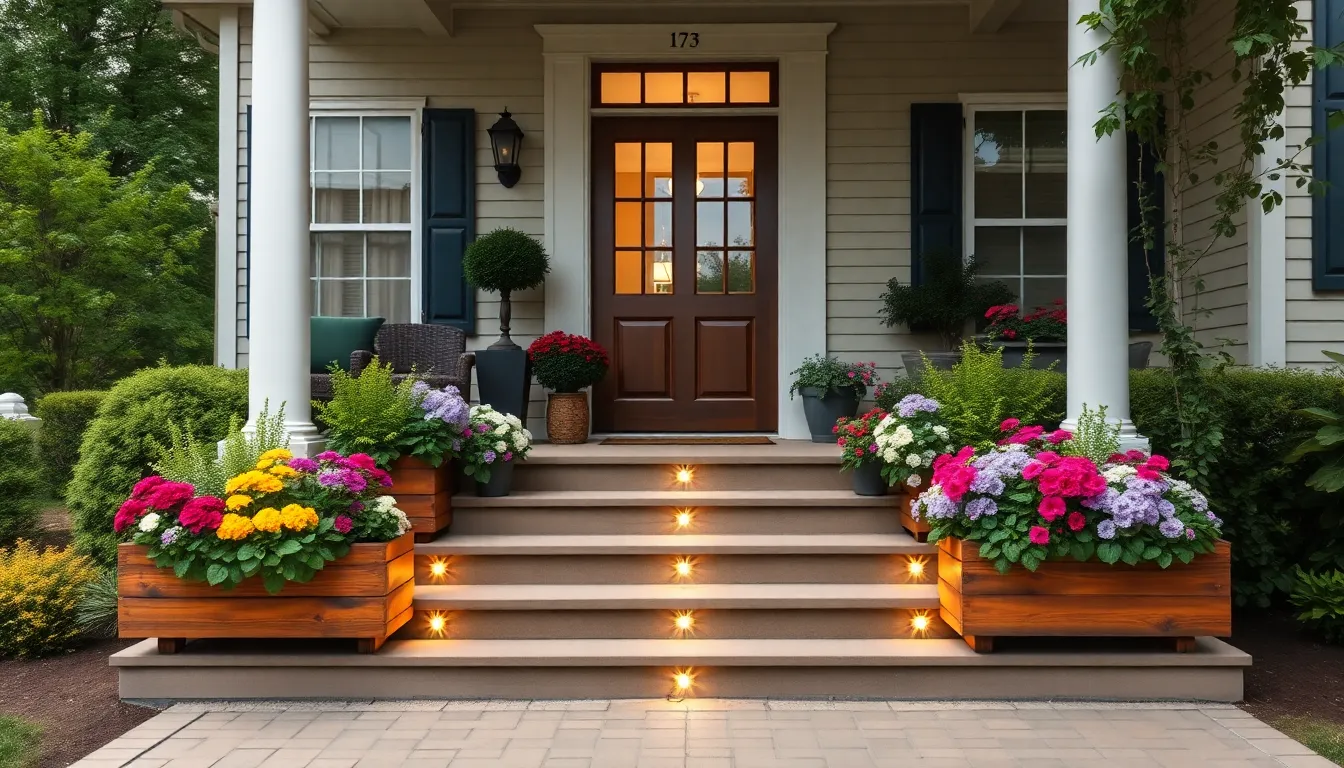
Improving your front porch stairs with thoughtful landscaping and decorative elements creates a seamless transition from your pathway to your entrance. We’ll explore strategic placement options that boost curb appeal while maintaining functionality around your stair design.
Flanking Planter Boxes
Positioning planter boxes on each side of your stairs creates instant symmetry and visual balance. These containers can be crafted from wood, stone, or composite materials to match your porch’s architectural style perfectly. Planter boxes soften the hard edges of your staircase while adding natural greenery or colorful blooms right at your entry point.
Wooden planters work beautifully with traditional and rustic home styles, while stone boxes complement modern concrete or natural stone stairs. Composite materials offer the advantage of weather resistance with minimal maintenance requirements. We recommend sizing your planters proportionally to your stair width for the most harmonious appearance.
Strategic placement ensures the boxes don’t obstruct foot traffic while maximizing their decorative impact. Consider elevating planters on small pedestals to create visual interest and improve drainage for your plants.
Seasonal Flower Arrangements
Rotating seasonal flowers in your planter boxes brings vibrant color that evolves throughout the year. Spring arrangements might feature tulips and daffodils in bright yellows and purples, while summer calls for bold petunias, marigolds, or geraniums in coordinating colors.
Autumn displays can incorporate orange pumpkins with golden mums, creating warm, welcoming combinations that pair beautifully with homes featuring green shutters or earth-tone siding. Winter arrangements benefit from evergreen plants combined with red berries or small ornamental cabbages for lasting visual appeal.
Color coordination with your door or home’s exterior colors creates a cohesive design approach. We suggest selecting 2-3 complementary colors that tie into your home’s existing palette rather than competing with it. Maintenance becomes easier when you choose plants suited to your local climate and sun exposure conditions.
Pathway Lighting Integration
Installing lighting along your pathway and stairs enhances both safety and evening ambiance around your entrance. LED step lights built directly into stair treads provide subtle illumination that highlights each level without creating harsh glare.
Solar path lights offer an eco-friendly solution that requires no electrical wiring while automatically activating at dusk. Position these lights alongside your planter boxes or integrated within larger decorative containers for dual functionality. Lantern-style fixtures mounted on posts create charming focal points that complement traditional and cottage-style homes.
We recommend combining multiple lighting types for layered illumination that serves different purposes. Step lights ensure safe navigation, while ambient pathway lighting creates a welcoming glow that showcases your landscaping elements after dark. Proper spacing between fixtures prevents dark spots while avoiding over-illumination that can feel harsh or unwelcoming.
Budget-Friendly DIY Front Porch Stair Projects
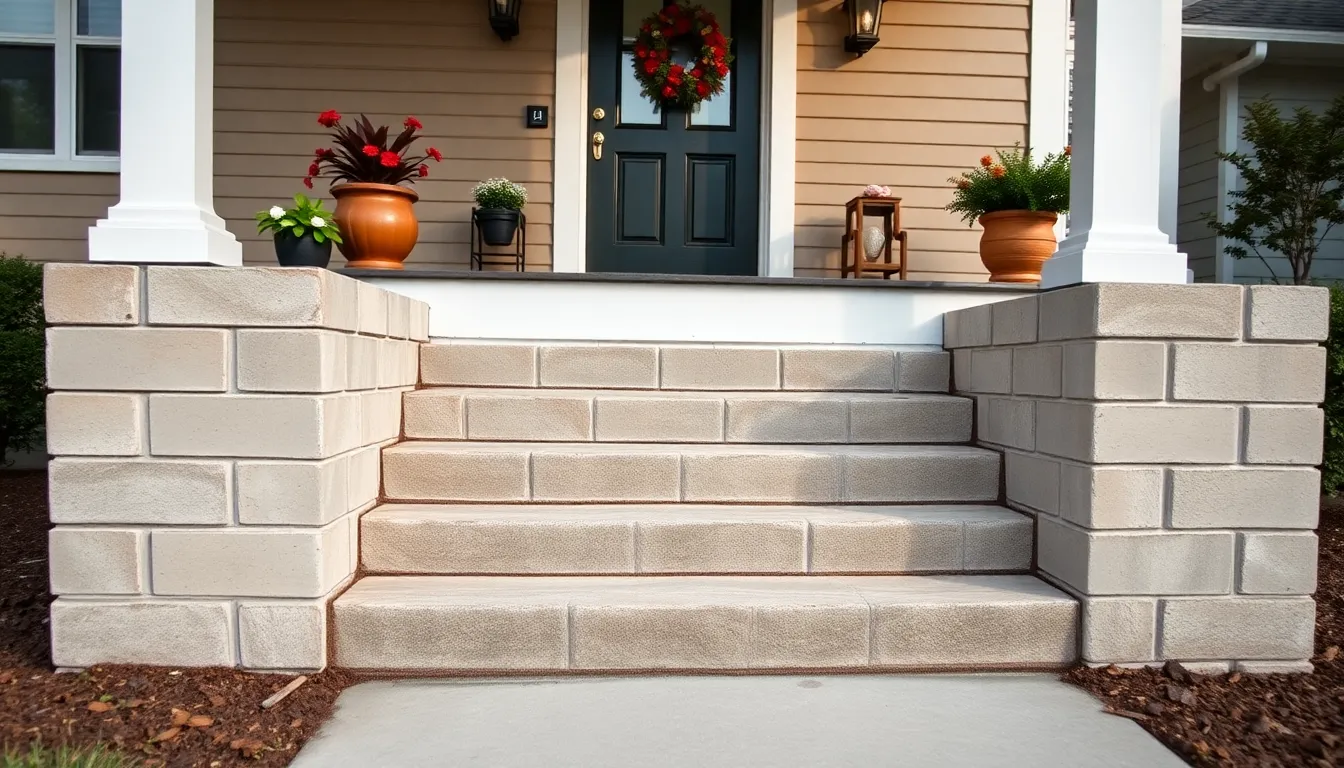
Creating beautiful front porch stairs doesn’t require a massive budget or professional contractor. We’ll explore three cost-effective approaches that deliver impressive results while keeping expenses manageable.
Concrete Block Step Construction
Concrete blocks provide an incredibly durable foundation for front porch stairs at a fraction of the cost of poured concrete. We stack these blocks using mortar to create sturdy steps that can support heavy foot traffic for decades. The basic construction involves laying blocks in a stepped pattern, ensuring each level is properly aligned and leveled.
Finishing options transform basic concrete blocks into attractive stairs that complement any home style. We can apply stone veneer for an upscale appearance or simply paint the blocks to match your home’s exterior colors. This method works particularly well for DIYers who have some masonry experience, though beginners can tackle smaller projects with proper preparation.
Cost breakdown for concrete block stairs:
| Material | Typical Cost | Coverage |
|---|---|---|
| Concrete blocks | $1-3 per block | 1 step per 2-3 blocks |
| Mortar mix | $4-6 per bag | 15-20 blocks |
| Stone veneer (optional) | $3-8 per sq ft | Varies by design |
| Paint (optional) | $25-40 per gallon | 300-400 sq ft |
Pressure-Treated Lumber Builds
Pressure-treated lumber offers excellent value for outdoor stair construction because of its natural resistance to rot and insects. We recommend building stringers with a 6-inch rise and 11-inch tread depth to ensure comfortable and safe navigation. This combination provides optimal dimensions that work well for most users, including those with mobility concerns.
Construction involves cutting stringers to the proper angle, attaching treads and risers, then securing the entire assembly to your porch structure. We often paint the risers white while staining the treads with natural wood tones to create an appealing contrast. This classic color combination works with virtually any home exterior and helps hide normal wear patterns.
Essential materials for pressure-treated lumber stairs:
| Component | Recommended Size | Typical Cost |
|---|---|---|
| Stringers | 2×12 pressure-treated | $15-25 each |
| Treads | 2×10 pressure-treated | $8-15 per board |
| Risers | 1×8 pressure-treated | $6-12 per board |
| Hardware | Galvanized screws/bolts | $20-35 total |
Upcycled Material Stair Ideas
Reclaimed and upcycled materials add unique character while reducing both costs and environmental impact. We love using salvaged wood planks for treads, which often feature beautiful weathered textures that new lumber simply can’t replicate. Matching stair riser colors to existing reclaimed siding creates a cohesive look that appears intentionally designed.
Creative finishing touches make upcycled stairs truly special without adding important costs. We suggest incorporating decorative elements like painted accents or small statues that reflect your personal style. Leftover wood planks from other projects work perfectly for treads, while concrete remnants can serve as sturdy risers when properly installed.
| Material Source | Potential Savings | Design Benefits |
|---|---|---|
| Salvaged wood | 50-70% vs new lumber | Unique weathered character |
| Reclaimed concrete | 30-50% vs new blocks | Interesting textures |
| Leftover house materials | 60-80% vs purchasing new | Perfect color matching |
| Architectural salvage | 40-60% vs reproductions | Authentic vintage details |
Conclusion
We’ve explored countless ways to transform your front porch stairs from simple functional elements into stunning architectural features. Whether you’re drawn to the timeless appeal of natural wood and stone or prefer the sleek lines of modern concrete and metal designs there’s a perfect solution for every home style and budget.
The key to successful front porch stair design lies in balancing functionality with aesthetics. By combining quality materials with thoughtful lighting landscaping and safety features you’ll create an entrance that not only welcomes guests but also adds important value to your home.
Remember that the best front porch stairs are those that reflect your personal style while complementing your home’s architecture. With proper planning and the right materials your new stairs will serve as a beautiful focal point for years to come.
Frequently Asked Questions
What are the most popular materials for front porch stairs?
The most popular materials include wood (pressure-treated lumber), concrete, natural stone (flagstone, granite), brick, and metal (wrought iron, steel, aluminum). Composite materials and recycled plastic are also gaining popularity for their durability and low maintenance requirements. Each material offers different aesthetic appeals and maintenance needs to suit various home styles and budgets.
How much do DIY front porch stairs typically cost?
DIY front porch stair costs vary significantly by material choice. Concrete block construction ranges from $200-500, pressure-treated lumber builds cost $300-800, while upcycled materials can cost under $200. Professional installation typically doubles these costs. The final price depends on stair size, material quality, and additional features like railings or lighting.
What safety features should I include in my front porch stair design?
Essential safety features include proper handrails and balusters with correct spacing, textured strips or non-slip surfaces on treads, adequate lighting for evening navigation, and proper step dimensions following building codes. Consider LED strip lighting, solar-powered step lights, or decorative lanterns to ensure safe passage while maintaining aesthetic appeal.
Can I mix different materials for my front porch stairs?
Yes, mixing materials creates unique and visually appealing designs. Popular combinations include steel frames with wooden treads, composite treads with natural wood railings, or stone steps with metal handrails. This approach allows for greater customization while balancing durability, maintenance needs, and aesthetic preferences within your budget.
How do I choose the right lighting for my front porch stairs?
Consider three main options: built-in LED strip lighting for subtle illumination along treads, solar-powered step lights for eco-friendly operation without wiring, or decorative lanterns for both charm and practical lighting. Choose based on your power source availability, desired ambiance, maintenance preferences, and overall design style.
What’s the best way to maintain different stair materials?
Wood stairs require regular staining or sealing every 2-3 years. Concrete needs occasional pressure washing and crack repair. Stone requires periodic cleaning and resealing. Metal stairs need rust prevention and paint touch-ups. Composite materials require minimal maintenance—just regular cleaning. Always follow manufacturer recommendations for specific products.
How can I enhance my front porch stairs with landscaping?
Add flanking planter boxes for symmetry, incorporate seasonal flower arrangements for year-round color, and ensure pathway lighting integration for safety and ambiance. Choose plants and materials that complement your home’s exterior colors and architectural style. Consider the scale and proportion of landscaping elements to maintain visual balance.

